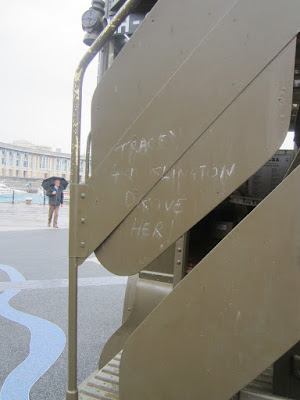Bristol Puppetry Festival was on over the long weekend and I’d intended to take a look at Asiel, a performance by Babok that features recycled household items, but there was no sign of it outside Arnolfini. Maybe it had been washed away by the rain. There was, however, a vaguely sheep-shaped lump of garish fibreglass just beyond M Shed, which had attracted a herd of dripping people taking photos.
Ooh look, it's Blackbeard Shaun the Sheep, following on from Blackbeard Gorilla in 2011 and Salty Sea Dog Gromit in 2013. About time they cut straight to the Charity auction, I think.
It's all so much less interesting than the B2737 Battle Bus on loan from the London Transport Museum which was parked alongside and which, apart from the occasional toddler being lifted to parp its horn, was ignored.
The B-type - the first ever mass-produced motor bus - went into service in 1910. They were commandeered for the war effort in 1914 and saw service as troop carriers, ambulances, lorries and even mobile pigeon lofts.
They then went back to being buses in 1918.
And look, it says - Tracey frm Islington drove her!
In the absence of puppets, I headed into the Arnolfini and found a different Dismaland in the form of an installation by Matt Davies and Milo Newman, entitled By the Mark, the Deep. ‘A sound installation that delves into the submerged ruins of the lost coastal town of Dunwich’, it consists of a room in total darkness, filled with the noises of shifting waves and silt, taken from sound recordings made directly at the site, now covered by the North Sea.
After a while, as I inched my way across the room, I made out what might have been a shelf, which vibrated alarmingly and turned out to be the sound system. Then, as my eyesight adjusted further, I swam towards a shimmering white shape which proved to be fire regulations.
The experience was surprisingly effective. More people came in, wondering how they would ever find their way back out and whether there was anyone else in there. ‘Yes,’ I said, ‘there’s me and I’ve been here six months.’
 Plunging from the atmospheric dark, I made my way to the exhibition of work by one of the UK’s foremost land artists, Bristol-based Richard Long, whose work I first encountered some years ago in Tate St Ives.
Plunging from the atmospheric dark, I made my way to the exhibition of work by one of the UK’s foremost land artists, Bristol-based Richard Long, whose work I first encountered some years ago in Tate St Ives. I find Long's work very interesting, primarily because it involves walking about a lot. Long documents his epic walks through the medium of photography, maps and text, re-imagining the relationship between art and landscape.
Perhaps the most immediate part of the exhibition is the offsite piece Boyhood Line, which follows a desire line trodden by users of the Downs near Ladies’ Mile for 170 metres, outlining it with white limestone rocks. The exhibition of Long’s work runs until 15th November.







No comments:
Post a Comment